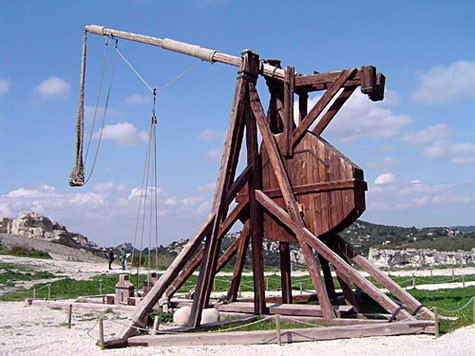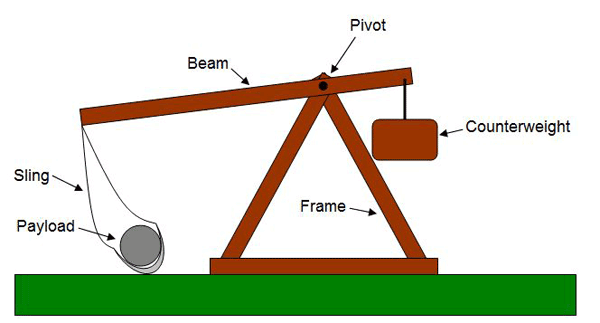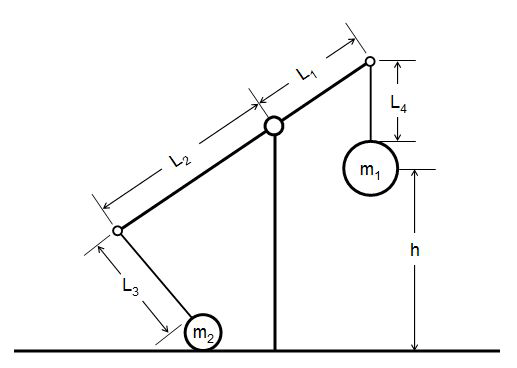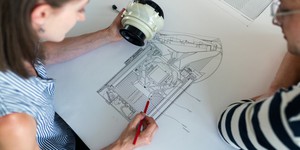Effect of Trebuchet Arm Length or Counterweight Mass on Projectile Distance
Summary
Ben Finio, PhD, Science Buddies

If you want a Project Idea with full instructions, please pick one without an asterisk (*) at the end of the title.
Abstract
Before cannons widely replaced them, siege engines were often used by armies to throw large stones and other projectiles to break down castle walls. One of the most advanced siege engines used in the Middle Ages was the trebuchet, which used a large counterweight to store energy to launch a payload, or projectile. The horizontal distance the payload would travel is called the trebuchet's range. Figure 1, below, shows a modern reconstruction of a trebuchet.
The range of a trebuchet has always been important. In the Middle Ages, soldiers had to make sure their trebuchets had a long enough range to stay outside the range of defending archers on castle walls. While they are no longer used in warfare, today people still build trebuchets for fun and use them in contests to see who can launch things the farthest. There are many different factors that can affect the range of a trebuchet; for example, the mass of the counterweight or the length of the lever arm. While designers of the Middle Ages had to rely largely on intuition or trial and error to build their trebuchets, modern builders have many helpful tools available. In addition to building prototypes of a trebuchet, you can also use physics calculations or even a computer simulation to help you design it to have the best range.

Figure 1. Reconstructed trebuchet at Château des Baux, France. The payload is loaded into the sling, at the long end of the lever arm (on the left). To launch the payload, first the long end of the lever arm is pulled down, which raises the counterweight suspended from the short end of the lever arm (on the right). Then, the long end of the lever is let go, and gravity pulls the counterweight down, whipping the long end of the lever arm up. The sling follows, and the payload is sent flying through the air (to the right). (Wikimedia Commons user Quistnix, 2005)
This abbreviated engineering project idea will help you get started with three different ways to investigate what factors can increase the range of a trebuchet:
- Trebuchet Physics: Use hand calculations to predict the range of a trebuchet based on its dimensions and other variables.
- Computer Simulations of a Trebuchet: Use computer simulations to predict the range of a trebuchet and modify its design.
- Building a Trebuchet: Build your own trebuchet and test it.
You can decide whether you want to try just one, two, or all three of these approaches. Read the relevant section(s) below for ideas on how to get started on your project.
Trebuchet Physics
If you want to do hand calculations to design a trebuchet with the best range, you will need to understand the physics involved. Figure 2, below, shows a diagram of a trebuchet with the main parts labeled. The trebuchet relies on the principle that stored potential energy of the counterweight can be converted into kinetic energy of the payload, launching it into the air.
 Image Credit: Ben Finio, Science Buddies / Science Buddies
Image Credit: Ben Finio, Science Buddies / Science Buddies
Figure 2. A diagram of the main parts of a trebuchet.
Figure 2 raises several questions about designing a trebuchet. To throw the payload as far as possible, how long should the beam be? Where should the pivot point be on the beam? How high off the ground should the pivot be? How heavy should the counterweight and the payload be? Figure 3, below, shows a sketch that can help you start thinking about how to set up the problem, and the variables involved.
 Image Credit: Ben Finio, Science Buddies / Science Buddies
Image Credit: Ben Finio, Science Buddies / Science Buddiesm1 is the mass of the counterweight in kilograms (kg). m2 is the mass of the payload (kg). h is the initial height of the counterweight off the ground. L1 is the distance between the pivot and the counterweight's attachment point in meters (m). L2 is the distance between the pivot and the sling's attachment point (m). L3 is the length of the sling (m). L4 is the length of the rope suspending the counterweight (this distance is zero if the counterweight is fixed directly to the lever arm) (m).
Figure 3. Schematic you can use to start analyzing the physics of a trebuchet. Note that m1 and m2 can be treated as point masses (so you do not need to account for their diamters), but are drawn larger in the figure.
The variables in Figure 3 are as follows:
- m1 is the mass of the counterweight in kilograms (kg).
- m2 is the mass of the payload (kg).
- h is the initial height of the counterweight off the ground.
- L1 is the distance between the pivot and the counterweight's attachment point in meters (m).
- L2 is the distance between the pivot and the sling's attachment point (m).
- L3 is the length of the sling (m).
- L4 is the length of the rope suspending the counterweight (this distance is zero if the counterweight is fixed directly to the lever arm) (m).
How can you use these variables to calculate the range of a trebuchet? There is more than one way to tackle the problem. Depending on your experience levels with math and physics, you can try the following approaches:
- If you have knowledge of basic physics concepts like projectile motion and conservation of energy, can you predict the maximum possible range of the trebuchet, assuming all of the counterweight's initial potential energy is converted to kinetic energy of the payload? Hint: Assume the payload leaves the sling at a launch angle of 45°.
- Can you derive equations that describe the position of the payload as a function of time, before and after it leaves the sling? Assume the trebuchet starts from rest with the counterweight at height h above the ground. What variables do you need to use to fully define the position of the trebuchet and the payload? Hint: They are not labeled in Figure 3. One of them is the angle of the lever arm, but do you need more than that?
- In either case, can you make your analysis more realistic by accounting for things like friction and air resistance? What about moments of inertia, which are not labeled in Figure 3?
This is a complex physics problem, so there are some references in the Bibliography to help get you started. If you get stuck, you may need to consult a physics textbook, ask your physics teacher for help, or do your own internet search for "trebuchet physics." Once you have derived an equation for the range of a trebuchet based on the physical parameters above, can you come up with any design guidelines or rules of thumb for designing a trebuchet with the best possible range?
Building a Trebuchet
This is probably the most exciting part of investigating how trebuchets work: actually building one! There are many different approaches to building a trebuchet, and you can find many different guides and designs online and in books (see the Bibliography for one example). Before you start building a trebuchet, ask yourself the following questions to help you pick a design:
- How much space do you have to test your trebuchet? Do you have a large outdoor area to test a big one? Do you need to build a miniature trebuchet that fits on a tabletop? Or something in between?
- What is your budget, and what materials do you have access to? Do you need to use household materials like cardboard, duct tape, and string? Can you make a trip to the hardware store and build your trebuchet with wood, nuts, and bolts?
- What tools and safety equipment do you have access to? Will you need help from an adult to use tools like a power drill or saw?
- How much time do you have to build your trebuchet? Do you have time to do a fancy design, or do you need to build one quickly?
- What should the various dimensions and parameters (lever arm length, counterweight mass, etc.) of your trebuchet be? Can you pick these parameters based on hand calculations or computer simulations (above), or based on design information you found through your own research?
- Do you want any of the parameters to be adjustable; for example, a bucket that you can fill with different weights for the counterweight, or a lever arm with notches or holes so you can change the pivot location and adjust the relative lengths of each side (L1 and L2 in Figure 3, above)?
What factors can increase the range of a real trebuchet, based on the one you build and test? For a very impressive science project, you could also compare the range of the trebuchet you build to predictions based on hand calculations and/or computer simulations you make (above). How closely do they match? What real-world things (like air resistance, or how exactly the payload is released from the sling) were difficult to account for in your calculations or simulations?
Objective
The goal of this project is to determine how different physical parameters can affect the range of a trebuchet, using hand calculations, computer simulations, and/or physical experiments.
Bibliography
These references will be useful for learning about the physics of trebuchets. Some of these references contain advanced math, including calculus and differential equations, but you can still use them to help you get started.
- Normani, F. (n.d.). Trebuchet Physics. Real World Physics Problems. Retrieved July 21, 2014.
- Mosher, A. (n.d.). A Mathematical Model for a Trebuchet. ESE 251 Presentation. Retrieved July 21, 2014.
If you search online, there are many different plans and designs for building a trebuchet. This book also contains some useful designs and building tips:
- Gurstelle, W., 2004. The Art of the Catapult: Build Greek Ballistae, Roman Onagers, English Trebuchets, and More Ancient Artillery. Chicago, IL: Chicago Review Press, Inc.
Autodesk Inventor software is available as a free download for students from:
- Autodesk, Inc. (n.d.). Inventor Professional for Education. Retrieved July 22, 2014.
Ask an Expert
Global Connections
The United Nations Sustainable Development Goals (UNSDGs) are a blueprint to achieve a better and more sustainable future for all.
Careers
If you like this project, you might enjoy exploring these related careers:











